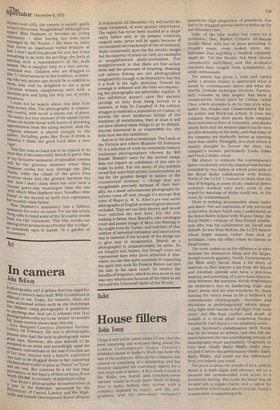Ballet
House fillers
Robin Young
I hope it will not be taken amiss if I say that the most surprising and welcome thing about the London Contemporary Dance Theatre's extended season at Sadler's Wells has been the size of the audiences. After all the company has existed on something of a shoestring, and has recently launched the customary appeal for a very large sum of money. A five-week season at the Wells, one feared and common-sense advised, would be much more likely to break than to make. Indeed, they started with a company depleted by injury, and the programmes, with the innovatory company's mandatory high proportion of premieres, has had to be rejigged several times to make up for lost rehearsal time.
None of the new works has come as a revelation. One, Robert Cohan's all-female Stabat Mater with lots of pious posturing to Vivaldi's music, even looked more oldfashioned than anything a classical company might do. Yet the theatre has been almost consistently well-filled, and the audience reactions have ranged from sympathetic to wildly enthusiastic.
The season has given a wide and varied public a greater chance to appreciate what is
meant by contemporary dance and what the Martha Graham technique involves. Particularly valuable in this respect has been a comparatively recent piece by Cohan, called Class, which attempts to do for this style what ballets like Etudes and Conservatoire did for the points and block-toe school. It runs the company through their paces, from simplest floor exercises to feats of virtuosity, and shows clearly both that the modern dance has its own peculiar demands on the body, and that some of the company are markedly better at meeting them than others. Strangely, in a style which is usually thought to favour the men, the company's women, particularly Linda Gibbs and Paula Lansley, excel.
The chance to compare the contemporary dance vocabulary with the classical was further extended by two ballets in which principals of the Royal Ballet collaborated with Robert North of the LCDT. I venture to think that the idea of bringing in some of the classical dance audience worked very well, even if the hoped-for marriage of styles could not, in the event, by consummated.
There is nothing incompatible about ballet and dance. Nor are exponents of one unversed in the other. Robert North was, I understand, at the Royal Ballet School with Wayne Sleep, the Royal Ballet's virtuoso of fleet-footed nimbleness who was his collaborator on David and Goliath. So was Ross McKim, the LC DT dancer whose larger stature, rather than lack of technique, ruins the effect when he dances in Sleep's place.
The work cashes in on the difference in sizes between the diminutive Sleep and the larger, though scarcely gigantic, North. Unfortunately the Bible story leaves them a bit short of material, so they borrow a bit from the David and Jonathan episode and have a previous meeting and something of a love-hate relation shop between the warriors. North emphasises his character's size by lumbering leaps and heavy poses, and his war-weariness by those fainting fits which seem to be a hallmark of contemporary choreography. Israelites and Philistines in undistinguished bikinis apparently fight their battles in full flight from each other, and the final conflict and death of Goliath is a trivial affair somewhat further dwarfed by Carl Davis's over-emphatic score.
Lynn Seymour's collaboration with North was by no means so witless, and also hid the seams between the two contributing schools of choreography more successfully. Originally to have been Gladly Badly Madly Sadly they retitled it before the performance Gladly Sadly Badly Madly, and could see the difference? Well, yes indeed, you could.
The piece is about the moods of love, and no doubt it is both slight and obvious, set to a pleasant but unmemorable rock score in a hackneyed setting. But Lynn Seymour has an incisive wit, a supple charm, and a talent for knockabout which make much of little. North's is essentially a supporting role.

































 Previous page
Previous page